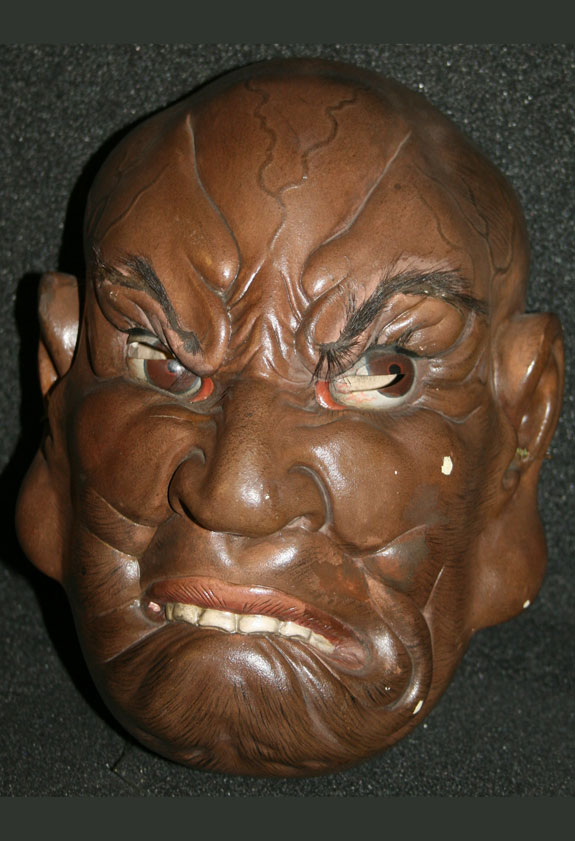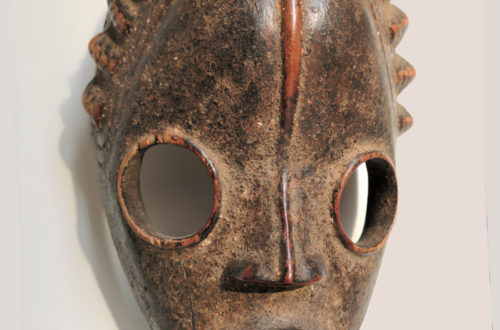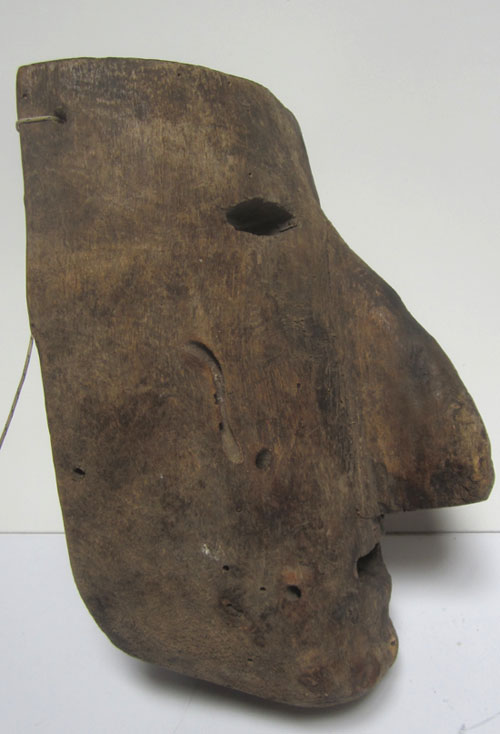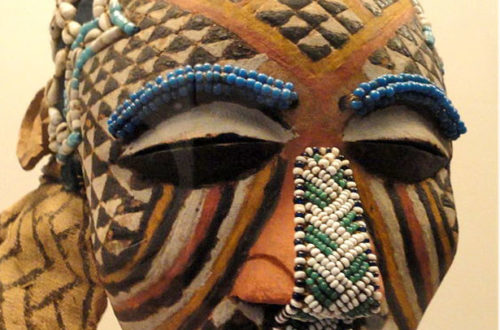 Q: Per your request are the attached pictures. I don’t know anything further than what was in my ad.
Q: Per your request are the attached pictures. I don’t know anything further than what was in my ad.
Antique, Turn of the Century, circa 1900-1920s
Ethnographic, hailing from Mexico
Thick patina, multiple layers of paint, quality craftsmanship
Made of what appears to be an oversized piece of cedar
Depicting a Caucasian Spaniard
Larger than most at: 15″ x 8″ x 6 1/2″ in depth
I’d love to know the character. The mask is larger than normal, and does have notable holes around the top that indicate something once was attached up there such as hair or otherwise. Nate, 1063
A: Masks like this are hard to find, so it’s great to see one for sale. Lets try to help you determine name of dance, the character, village, state, etc. Opinions from visitors who collect Mexican masks are welcomed. A

A: Masks like this are hard to find, so it’s great to see one for sale. Lets try to help you determine name of dance, the character, village, state, etc. Opinions from visitors who collect Mexican masks are welcomed. A







5 Comments
Aaron
Hey, Nate! An old ermitaño from Michoacán? If not, my second guess would be a moro from maybe Veracruz. The placement of the eye holes is throwing me off.
Nate
Well thanks Aaron.
I too noticed the eye hole placement. They are definitely very fine and small, and perfectly symmetrical and also closer to the bridge of the nose than I’ve seen. Probably a trade mark item of this carver if ever someone got so lucky to find another piece by this artist. That is always an interesting ebb and flow. I collected 4-5 Japanese masks by the same, signed artist once, and saw 1-2 other examples for sale at that same time. Didn’t buy them and they sold immediately after. I couldn’t tell if i missed an opportunity or not…. but its been 5+ years now and I haven’t see another come to market by that artist.
I am going to definitely run with your theory on this being a hermit or “recluse” i.e. ermitaño. That is the same direction I had just recently leaned in too. Super long beard, and the angle/length of the moustache flowing into it seem to indicate the character the most. Apparently if you made a hermit in the art deco period which i think the piece may be from… you had to keep him a bit more clean-looking and kept. More modern versions certain are a bit more disheveled.
Lastly – and hes a big leap… There are those that think that what is modern day Michigan – USA… is actually where the ancient Aztecs originated before they migrated further south to what is currently Mexico today. The language trail in fact reaffirms this fact that both “Michigan” and “Michoacán” have the same roots/meaning. There are underwater pyramids of Michigan that no one as attributed to any natives yet and some very early US maps that noted that “the home of the aztecs” was next to Salt Lake Utah and a few other migratory landings in between, under similar namings, under other early maps.
Bob Ibold
Aaron and Nate:
The paint suggests that this is an old mask from Michoacán. But this is not an Hermitaño, it is Tarepiti, “Grandfather,” or San José. He dances with Maringuilla, “little Mary, La María, aka the Virgin Mary, in the Viejitos or Cúrpites dance. There are very few Mexican masks that represent saints- this is one of them.
I will attach a more recent example by Antonio Saldaña.
Bryan
Bob Ibold
Aaron and Nate:
The paint suggests that this is an old mask from Michoacán. But this is not an Hermitaño, it is Tarepiti, “Grandfather,” or San José. He dances with Maringuilla, “little Mary, La María, aka the Virgin Mary, in the Viejitos or Cúrpites dance. There are very few Mexican masks that represent saints- this is one of them.
I will attach a more recent example by Antonio Saldaña.
Bryan Stevens
Nate
Much obliged Bob; I’ll stick with your research over mine. Thanks for sharing your infinite wisdom.